Over the Easter holidays, I was lucky enough to spend a couple of days with my aunt and my two children in Wiltshire, whilst my husband was away on a trip. We booked a lovely bed and breakfast for two nights and enjoyed some fun excursions to nearby Lacock and Bath. On our way home to Kent, I decided that we would make a few stopovers along the way, as we would be fairly close to some of the Wiltshire villages where my ancestors once lived. I didn’t want to pass up on the opportunity to make some visits. It was a beautiful sunny day but there was a cold wind, so I jumped out of the car quickly, leaving everyone else inside, whilst I scurried around taking photographs. I didn’t have a lot of time but I always made a beeline for the church, hoping to find it open. If I was really lucky, I might be able to find a printed parish history, or a postcard or two that I could purchase.
For me, churches are places where I feel a very tangible connection to past generations. I may not be able to identify the home where an ancestor once lived, it may have long gone, but the parish church remains, as it has done so for hundreds of years. I think about the many times an ancestor would have walked along the path to church, entering the porch before stepping into the cool embrace of its stone walls. Each Sunday, they would have sat in the pews and heard the familiar rhythms of the service, the music, the reading of the psalms, and the recitation of the Lord’s Prayer. The bells of the church would have rung out on their wedding day, when they walked hand in hand down the aisle with their beloved and to mark the birth of each baby, they would have gathered around the font, close to the door, perhaps where they too had been baptised some years previously. The church was also the place where last journeys were made before they were laid to rest in the churchyard.
One place I was particularly keen on visiting was Compton Bassett. It’s a tiny parish in north Wiltshire, just east of Calne on the edge of the Marlborough Downs. You can find it away from the main road and along a network of lanes, situated in picturesque rolling countryside. Until recently, the singer, Robbie Williams, had a home here, created from the stables of Compton Bassett House, a large country house which was demolished in the 1930s. The entrance gates to his former house are just opposite the church and workmen were fixing them as we drew up to park.

My ancestor, the distinctively named Angel Bullock, was baptised in Compton Bassett on August 26th 1810, the youngest son of Josiah Bullock and his wife, Sarah, née Styles:

Angel was an agricultural labourer, just like generations of Bullocks before him, and would have worked on one of the seven farms in the parish:
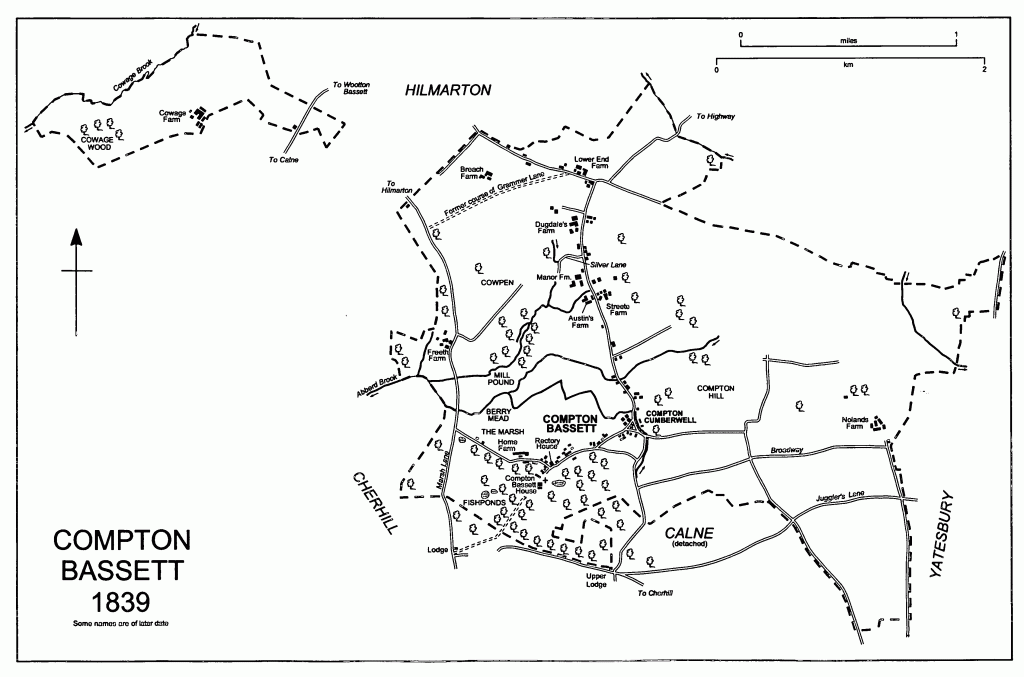
https://www.british-history.ac.uk/vch/wilts/vol17/pp146-159
Whilst still a young man, Angel Bullock married his sweetheart, Eliza Ponting, at the parish church on June 15th 1834. I can imagine the happy couple standing in front of the altar saying their vows, one after the other, and Angel placing a ring on the finger of his bride as a symbol of his love and commitment to her.
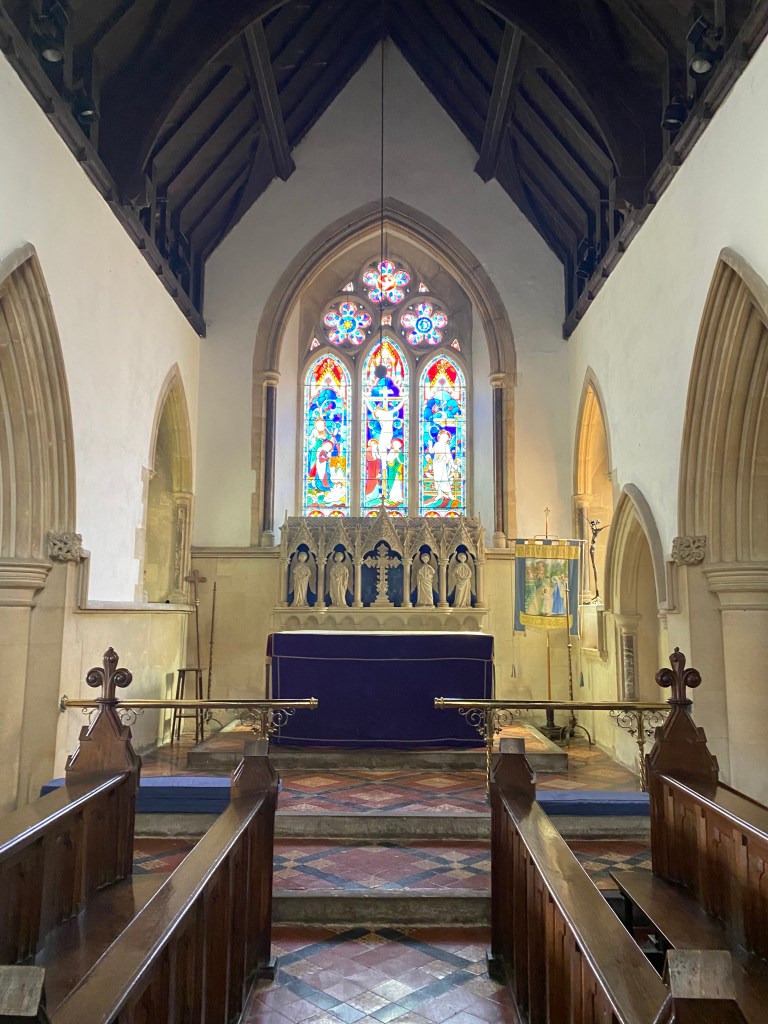
Together, Angel and Eliza would have walked down the aisle, through the archway that forms part of the screen of beautiful 15th century filagree stone tracery that adorns the church, whilst their family and friends in the pews either side looked on:
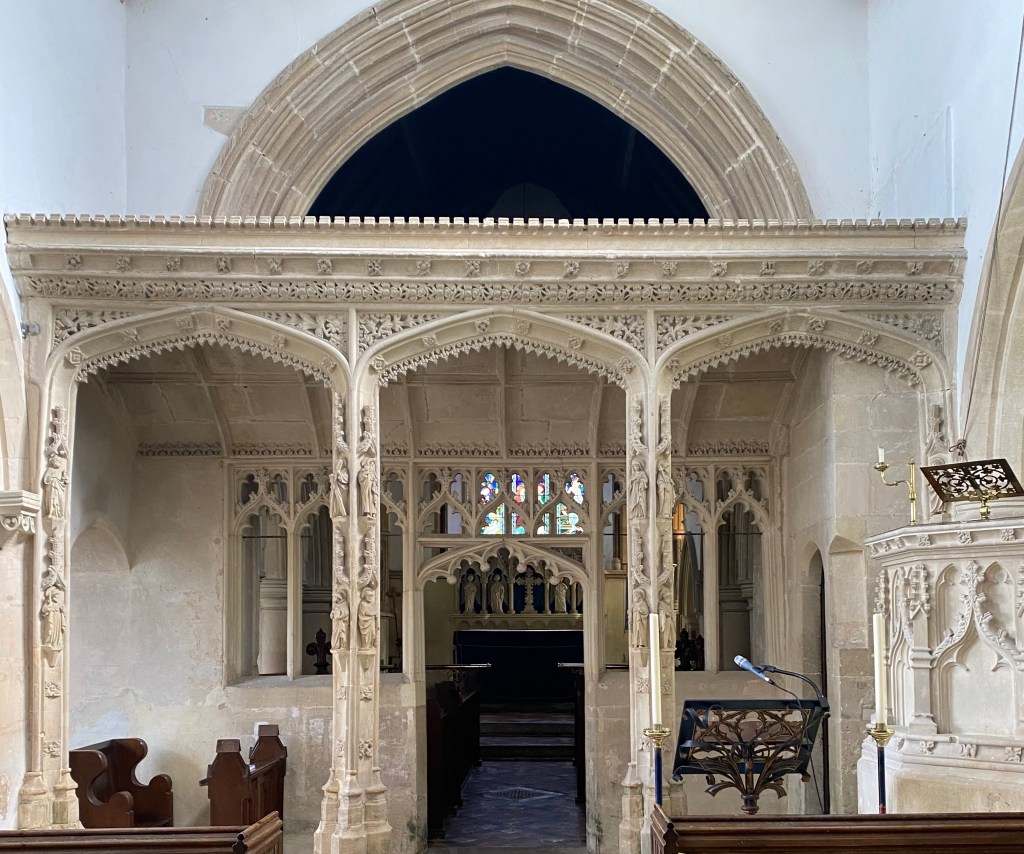
There are some beautiful stained glass windows in the church, commemorating past owners of Compton Bassett House. During Angel’s lifetime, George Walker Heneage, (1799-1875), the M.P. for Devizes and a J.P. for Wiltshire, was the lord of the manor and the owner of Compton Bassett House. He owned 1813 acres in the parish in 1838.
After bringing up a family of eight children, Eliza died on April 11th 1867 at the age of 59 and was buried in the churchyard at Compton Bassett. Angel remarried the following year and continued living in Compton Bassett with his second wife, Ann, until his death aged 73 on December 6th 1883.
Many years ago, in the mid-1990s, I visited Compton Bassett for the first time with the particular purpose of locating the grave of Angel Bullock and his first wife, Eliza. I was accompanied by my boyfriend, now my husband, who I roped in to help search the churchyard. I told him that we would spread out to cover the area efficiently, he going one way, I going the other. We had only just parted when almost immediately, he shouted out that he had found what we were looking for. Close to the door of the church, in a rather obvious position, was a gravestone commemorating Angel and Eliza Bullock. It was quite a coup for my husband and for years afterwards, he has used his discovery as evidence of his support for my genealogical interests. Winding forwards to 2022, I was keen to find the gravestone again so I could take some more photographs. I am sure I took some originally too, some thirty years ago, but they are probably buried somewhere in a box in the loft, waiting to be unearthed.
As I knew where to find the gravestone, I convinced my children to come out of the car and accompany me so I could proudly show them the grave of their 4th great grandparents. The church looked beautiful in the Spring sunshine and the churchyard was bedecked by yellow primroses:
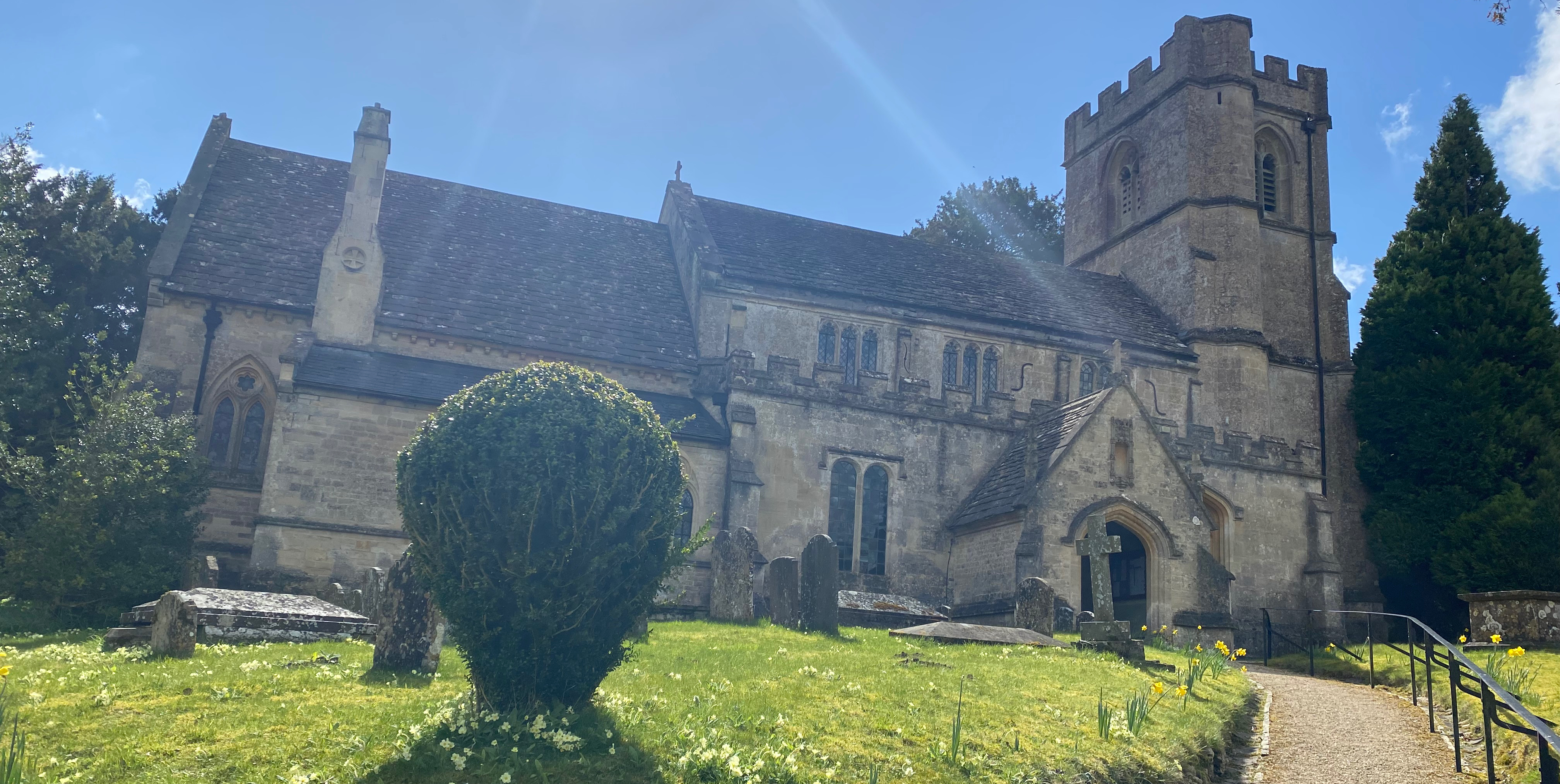
© Judith Batchelor
I walked up the path to the church and looked for the gravestone, which I had remembered was just to the left of the porch. This is what I found:
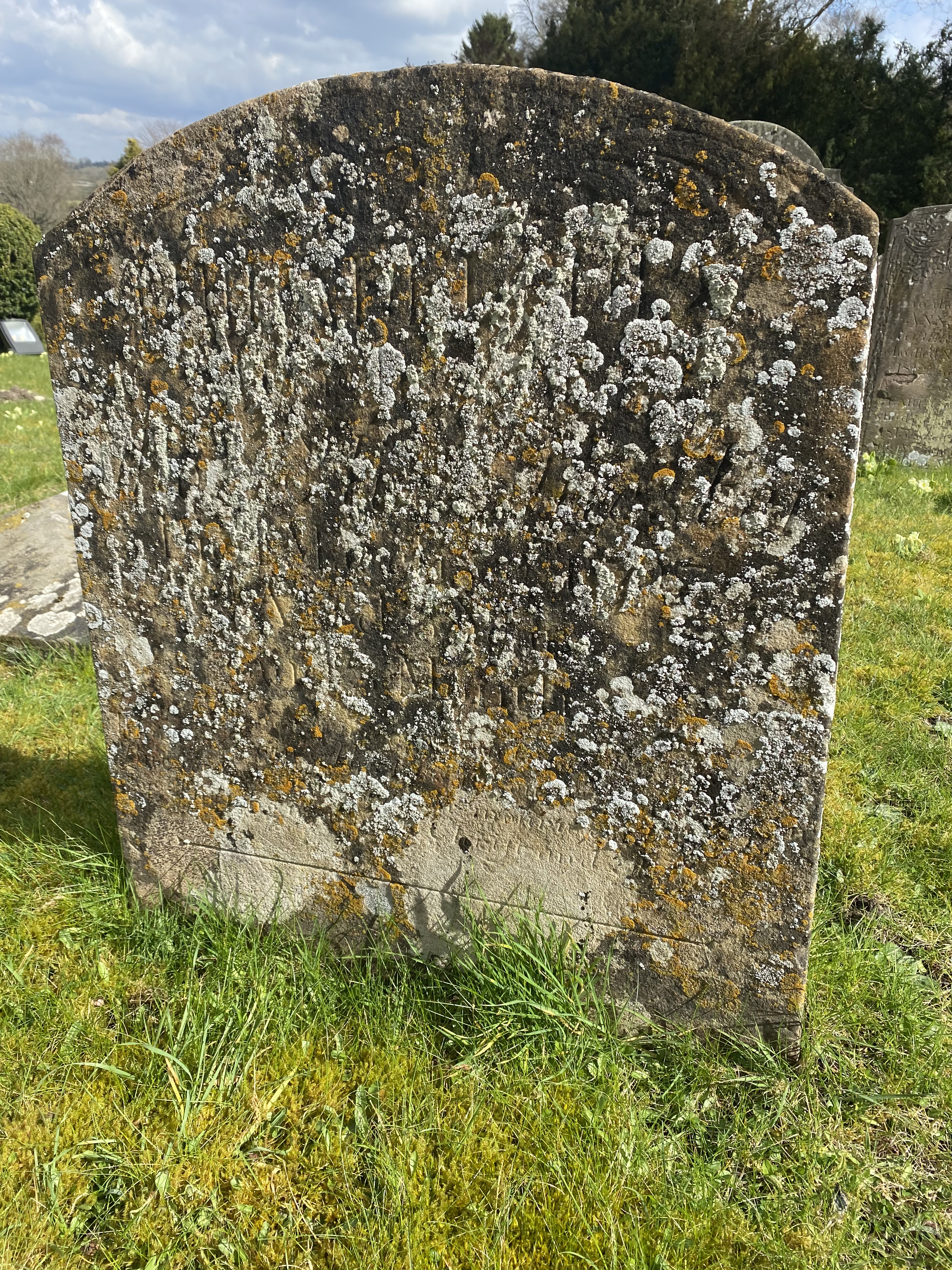
Compton Bassett churchyard, Wiltshire © Judith Batchelor
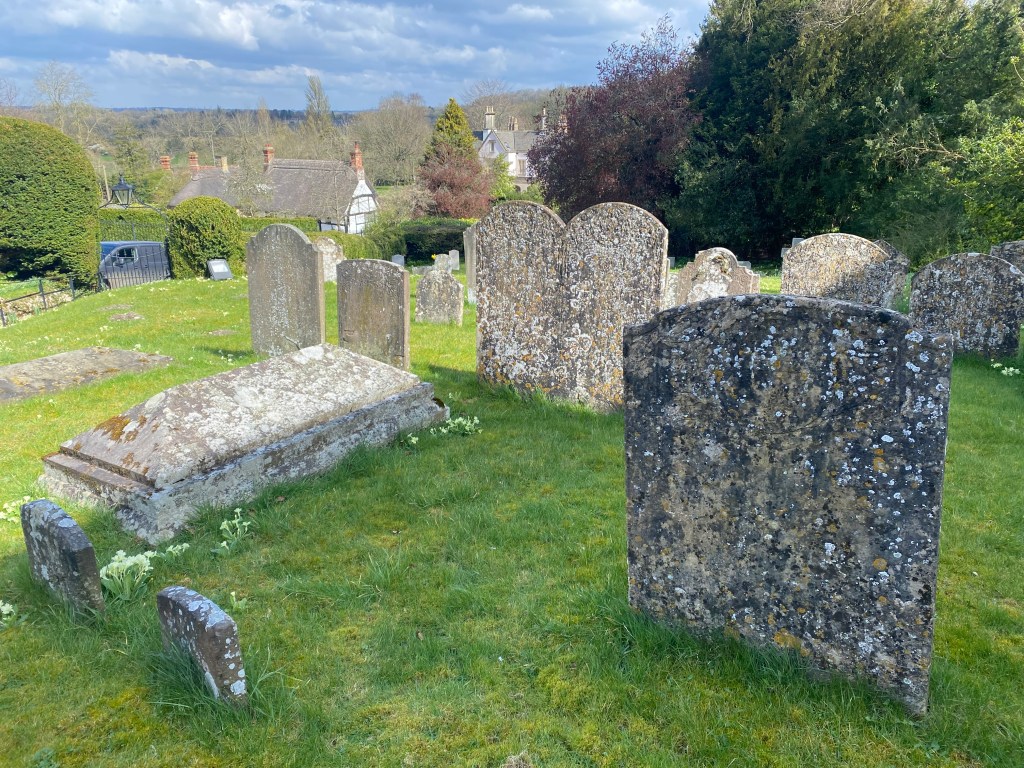
Compton Bassett churchyard, Wiltshire © Judith Batchelor
I was most disappointed to find that the gravestone was almost completely illegible. Covered in lichen, like many others in the churchyard, it was indecipherable. Was my memory faulty? Certainly, there didn’t seem to be any other possible candidates. Almost thirty years previously, the memorial had been easy to spot and identify so it was a big shock. I had no time to attempt to clean the stone, even if that was a possibility. I knew that its existence couldn’t be entirely a figment of my imagination, as there is an entry for the couple in a collection of memorial inscriptions made by Wiltshire Family History Society, though probably due to its unfamiliarity, Angel’s forename has been left as a blank.
My task now will be to see if I can find the photographs of my original visit to Compton Bassett, from all those years ago. Hopefully, I will find the evidence and be able to prove that the gravestone above does indeed mark the final resting place of Angel and Eliza Bullock. However, I wanted to share my story, in part, as a cautionary tale. Even in our own lifetimes, memorials are deteriorating fast. It is therefore really important that inscriptions are recorded as soon as possible. For some years now, family history societies have done a wonderful job of noting down memorial inscriptions in churchyards across the country. Without their efforts, many inscriptions would have surely been lost. There are also a number of websites which record memorial inscriptions. Volunteers from Find a Grave (http://www.findagrave.com) have been recording memorial inscriptions since 1995, and a collection of over 210 million memorials from around the world are available to search online. Commercial organisations such as BillionGraves (http://www.billiongraves.com) and Deceased Online (http://www.deceasedonline.com) are also engaged in this work. One piece of good news is the launch of the new National Burial Grounds Survey. The aim of the project is to create a digital map and database of burial grounds in England. More details can be found here:
https://www.churchofengland.org/resources/churchcare/churchcare-news/national-burial-grounds-survey
As my story illustrates, time is running out to identify and record the inscriptions on these important monuments, which bear witness to the lives of our ancestors. In addition, although it is wonderful to have a record of the inscription, it is even better if you can identify exactly where your ancestors are buried and see the memorial for yourself. It is all about making that tangible connection with the past.
© Judith Batchelor 2022



I was enjoying your “tour” until I saw the gravestone photo. What a shock! Totally agree with you, we need to preserve these stones physically and digitally so the people and information aren’t lost to the mists of time. A cautionary tale.
LikeLiked by 1 person
I was so disappointed, as you can imagine. I now need to take a trip to the loft!
LikeLike
Hi Jude,I just wanted to say what an excellent article this is. Thanks so much. I really enjoyed reading it over my morning coffee.SueSent from my Galaxy
LikeLiked by 1 person
Thank you so much Sue! I am glad it was a good accompaniment to your morning coffee.
LikeLike
Oh, you got to touch the past! How wonderful. Findagrave.com do such wonderful work. Thank you for the article and for the info about the planned National burial grounds survey – very interesting!
LikeLiked by 1 person
I love visiting churches! Always something fascinating to catch your eye.
LikeLike
Hi Jude. I enjoyed the journey into your family history, especially with the photos to illustrate the importance of churches and graveyards to you. I am inspired to write an ancestral post to showcase some recent research for my family. Your suggestion that the local church is the central focus for the family got me thinking about the churches I need to research online, as I am unlikely to make another trip back to England and Wales in my lifetime.
LikeLiked by 1 person
Hi Carole, it’s great to know that you have been inspired to write your own post on your research. Although it is wonderful to be able to visit a church in person, there are lots of resources online. I wrote an article the other year about how to research a parish, which you may find useful: https://genealogyjude.com/2020/10/17/an-english-village-how-to-find-out-about-a-place/
LikeLiked by 1 person
Hi Jude, that is a wonderful guide to finding out more about an Ancestral Village. It is just what I was looking for when I began my own Ancestral Heritage Trails. I have passed it on to my followers. It would make a great printed PDF Guide to share.
LikeLiked by 1 person
Thanks for sharing Carole.
LikeLike
Jude – thank you so much for this very interesting post. What a shame about the gravestone. I hope you find the photo you originally took. I was fortunate enough to have a volunteer kindly send me photos of my great grandparents’ grave in Liverpool which unknown to me, was only a stone’s throw from where I went to high school. It meant so much to me since most of my ancestors were buried in public graves without any memorials. I totally agree with you that these headstones need to be conserved for posterity before it’s too late.
LikeLiked by 2 people
Great that somebody took those photos for you. You never know what might be recorded either.
LikeLike
Thanks again for a fascinating post with great photos. I’m so envious! I love old churches and cemeteries but I am in Australia the other side of the world from my ancestry – UK and Canada. A huge thank you to all the volunteers recording and posting grave information. I have learned so much. Thank goodness I took a photo decades ago of my husbands grandparents’ stone while on holiday in West Sussex. It is now online and I can see the deterioration.
LikeLiked by 1 person
Thanks Lynn! Like you, I am very grateful to all the volunteers who do such wonderful work recording monumental inscriptions.
LikeLike
I hope you manage to find the photos from the 1990’s. I recently visited the cemetery where many of my ancestors were buried, which I have visited many times before. I have to say, my third great grandfather’s grave seemed to be showing more signs of wear. Thankfully I have many photographs and have recorded the inscription. For another grave, the one I went to locate on this visit, the monument was in a very bad state. Many of the lead letters were missing or scattered around and the monument was laid flat. Thankfully I managed to record the entire inscription from the holes used to pin the letters in place.
LikeLiked by 1 person
Glad that you had some success! It really is a race against time in many cases.
LikeLiked by 1 person
Very much so and a fact I discovered only last week. Now I need to find the photos from about twenty years ago!
LikeLiked by 1 person
Hi Jude, it is possible to get a gravestone professionaly restored/cleaned, which I am sure you are already aware of. I will send you a picture before and after of my Mum and Dads grave to show you what’s possible.
LikeLiked by 1 person
You did a great job! Such a worthwhile thing to do.
LikeLiked by 1 person